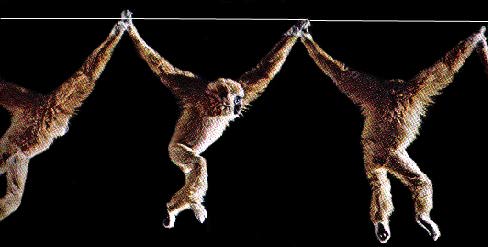
 |
Gibbons |
Gibbons are found only in southeast Asia. They live in rain forests, and are usually found in the canopy of the trees. However, they have been observed on the ground and in the highest branches of the trees. The Gibbon dental formula is 2:1:2:3. They eat leaves, fruit, insects and bird eggs.
Proportions of arms and legs illustrate the specialization for brachiation. Shoulder joints also allow for flexible rotation of the shoulders and arms. A short body and legs make gibbons relatively light weight.

Gibbons are true brachiators. That means they are able to arm swing through the trees. They also climb and leap. On the ground they walk bipedally with their arms held out to their sides. Their forearms are much longer than their hindlimb.
When upright, Gibbons stand more erect than any other primate except for man.
Gibbons live in male-female pairs (pair bonds), that will include children. Lone indivduals are either old, or young animals attempting to leave the nest and start their own family. Gibbons show no signs of sexual dimorphism that is common in many other primates. This is due to the relationships they form socially that pair males and females for life. Gibbons will sign songs to each other to help maintain this bonded relationship...gibbons frown on divorce in otherwords and want to know where each other is when they are separated!